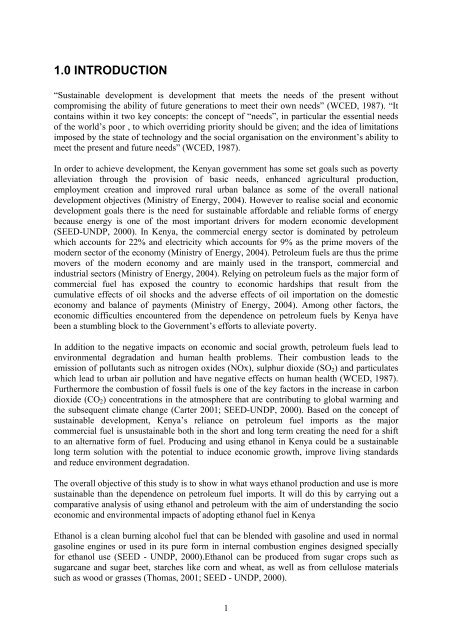ethanol fuel production and use in kenya for sustainable ... - lumes
ethanol fuel production and use in kenya for sustainable ... - lumes
ethanol fuel production and use in kenya for sustainable ... - lumes
You also want an ePaper? Increase the reach of your titles
YUMPU automatically turns print PDFs into web optimized ePapers that Google loves.
1.0 INTRODUCTION“Susta<strong>in</strong>able development is development that meets the needs of the present withoutcompromis<strong>in</strong>g the ability of future generations to meet their own needs” (WCED, 1987). “Itconta<strong>in</strong>s with<strong>in</strong> it two key concepts: the concept of “needs”, <strong>in</strong> particular the essential needsof the world’s poor , to which overrid<strong>in</strong>g priority should be given; <strong>and</strong> the idea of limitationsimposed by the state of technology <strong>and</strong> the social organisation on the environment’s ability tomeet the present <strong>and</strong> future needs” (WCED, 1987).In order to achieve development, the Kenyan government has some set goals such as povertyalleviation through the provision of basic needs, enhanced agricultural <strong>production</strong>,employment creation <strong>and</strong> improved rural urban balance as some of the overall nationaldevelopment objectives (M<strong>in</strong>istry of Energy, 2004). However to realise social <strong>and</strong> economicdevelopment goals there is the need <strong>for</strong> susta<strong>in</strong>able af<strong>for</strong>dable <strong>and</strong> reliable <strong>for</strong>ms of energybeca<strong>use</strong> energy is one of the most important drivers <strong>for</strong> modern economic development(SEED-UNDP, 2000). In Kenya, the commercial energy sector is dom<strong>in</strong>ated by petroleumwhich accounts <strong>for</strong> 22% <strong>and</strong> electricity which accounts <strong>for</strong> 9% as the prime movers of themodern sector of the economy (M<strong>in</strong>istry of Energy, 2004). Petroleum <strong>fuel</strong>s are thus the primemovers of the modern economy <strong>and</strong> are ma<strong>in</strong>ly <strong>use</strong>d <strong>in</strong> the transport, commercial <strong>and</strong><strong>in</strong>dustrial sectors (M<strong>in</strong>istry of Energy, 2004). Rely<strong>in</strong>g on petroleum <strong>fuel</strong>s as the major <strong>for</strong>m ofcommercial <strong>fuel</strong> has exposed the country to economic hardships that result from thecumulative effects of oil shocks <strong>and</strong> the adverse effects of oil importation on the domesticeconomy <strong>and</strong> balance of payments (M<strong>in</strong>istry of Energy, 2004). Among other factors, theeconomic difficulties encountered from the dependence on petroleum <strong>fuel</strong>s by Kenya havebeen a stumbl<strong>in</strong>g block to the Government’s ef<strong>for</strong>ts to alleviate poverty.In addition to the negative impacts on economic <strong>and</strong> social growth, petroleum <strong>fuel</strong>s lead toenvironmental degradation <strong>and</strong> human health problems. Their combustion leads to theemission of pollutants such as nitrogen oxides (NOx), sulphur dioxide (SO 2 ) <strong>and</strong> particulateswhich lead to urban air pollution <strong>and</strong> have negative effects on human health (WCED, 1987).Furthermore the combustion of fossil <strong>fuel</strong>s is one of the key factors <strong>in</strong> the <strong>in</strong>crease <strong>in</strong> carbondioxide (CO 2 ) concentrations <strong>in</strong> the atmosphere that are contribut<strong>in</strong>g to global warm<strong>in</strong>g <strong>and</strong>the subsequent climate change (Carter 2001; SEED-UNDP, 2000). Based on the concept ofsusta<strong>in</strong>able development, Kenya’s reliance on petroleum <strong>fuel</strong> imports as the majorcommercial <strong>fuel</strong> is unsusta<strong>in</strong>able both <strong>in</strong> the short <strong>and</strong> long term creat<strong>in</strong>g the need <strong>for</strong> a shiftto an alternative <strong>for</strong>m of <strong>fuel</strong>. Produc<strong>in</strong>g <strong>and</strong> us<strong>in</strong>g <strong>ethanol</strong> <strong>in</strong> Kenya could be a susta<strong>in</strong>ablelong term solution with the potential to <strong>in</strong>duce economic growth, improve liv<strong>in</strong>g st<strong>and</strong>ards<strong>and</strong> reduce environment degradation.The overall objective of this study is to show <strong>in</strong> what ways <strong>ethanol</strong> <strong>production</strong> <strong>and</strong> <strong>use</strong> is moresusta<strong>in</strong>able than the dependence on petroleum <strong>fuel</strong> imports. It will do this by carry<strong>in</strong>g out acomparative analysis of us<strong>in</strong>g <strong>ethanol</strong> <strong>and</strong> petroleum with the aim of underst<strong>and</strong><strong>in</strong>g the socioeconomic <strong>and</strong> environmental impacts of adopt<strong>in</strong>g <strong>ethanol</strong> <strong>fuel</strong> <strong>in</strong> KenyaEthanol is a clean burn<strong>in</strong>g alcohol <strong>fuel</strong> that can be blended with gasol<strong>in</strong>e <strong>and</strong> <strong>use</strong>d <strong>in</strong> normalgasol<strong>in</strong>e eng<strong>in</strong>es or <strong>use</strong>d <strong>in</strong> its pure <strong>for</strong>m <strong>in</strong> <strong>in</strong>ternal combustion eng<strong>in</strong>es designed specially<strong>for</strong> <strong>ethanol</strong> <strong>use</strong> (SEED - UNDP, 2000).Ethanol can be produced from sugar crops such assugarcane <strong>and</strong> sugar beet, starches like corn <strong>and</strong> wheat, as well as from cellulose materialssuch as wood or grasses (Thomas, 2001; SEED - UNDP, 2000).1
















